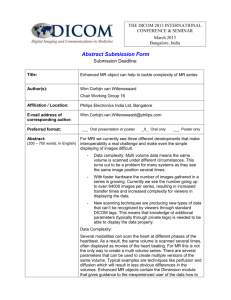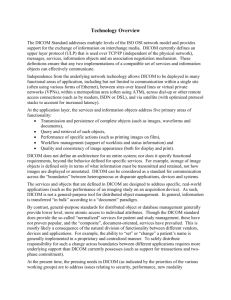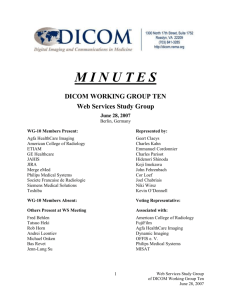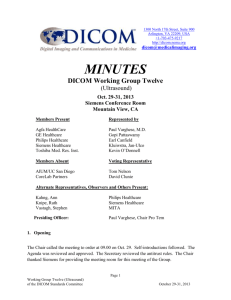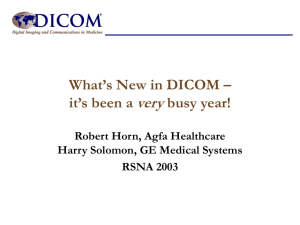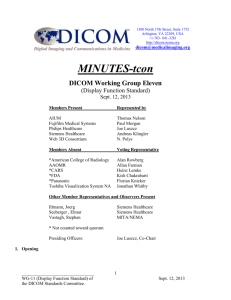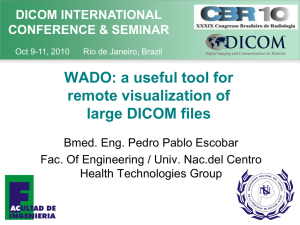American Society for Echocardiography Software Suite for Verification ... Playback of Ultrasonic Cin6-Mode Images
advertisement
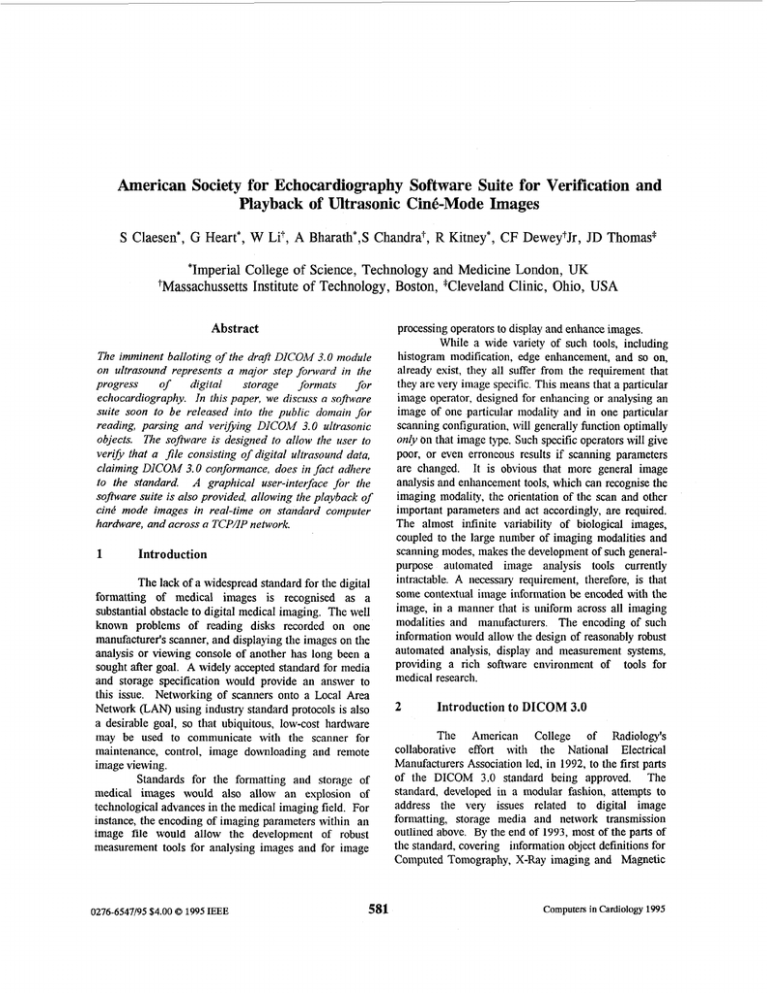
American Society for Echocardiography Software Suite for Verification and Playback of Ultrasonic Cin6-Mode Images S Claesen*, G Heart*, W Lit, A Bharath*,S Chandrat, R Kitney*, CF DeweytJr, JD Thomas* *Imperial College of Science, Technology and Medicine London, UK 'Massachussetts Institute of Technology, Boston, *Cleveland Clinic, Ohio, USA Abstract The imminent balloting of the draft DICOM 3.0 module on ultrasound represents a major step forward in the progress of digital storage formats for echocardiography. In this paper, we discuss a software suite soon to be released into the public domain for reading, parsing and verifying DICOM 3.0 ultrasonic objects. The software is designed to allow the user to verify that a Jle consisting of digital ultrasound data, claiming DlCOM 3.0 conformance, does in fact adhere to the standard. A graphical user-interface for the software suite is also provided, allowing the playback of cin& mode images in real-time on standard computer hardware, and across a TCP/IP network. 1 Introduction The lack of a widespread standard for the digital formatting of medical images is recognised as a substantial obstacle to digital medical imaging. The well known problems of reading disks recorded on one manufacturer's scanner, and displaying the images on the analysis or viewing console of another has long been a sought after goal. A widely accepted standard for media and storage specification would provide an answer to this issue. Networking of scanners onto a Local Area Network (LAN) using industry standard protocols is also a desirable goal, so that ubiquitous, low-cost hardware may be used to communicate with the scanner for maintenance, control, image downloading and remote image viewing. Standards for the formatting and storage of medical images would also allow an explosion of technological advances in the medical imaging field. For instance, the encoding of imaging parameters within an image file would allow the development of robust measurement tools for analysing images and for image 0276-6547195 $4.00 6 1995 IEEE 581 processing operators to display and enhance images. While a wide variety of such tools, including histogram modification, edge enhancement, and so on, already exist, they all suffer from the requirement that they are very image specific. This means that a particular image operator, designed for enhancing or analysing an image of one particular modality and in one particular scanning coilfiguration, will generally function optimally only on that image type. Such specific operators will give poor, or even erroneous results if scanning parameters are changed. It is obvious that more general image analysis and enhancement tools, which can recognise the imaging modality, the orientation of the scan and other important parameters and act accordingly, are required. The almost infinite variability of biological images, coupled to the large number of imaging modalities and scanning modes, makes the development of such generalpurpose automated image analysis tools currently intractable. A necessary requirement, therefore, is that some contextual image information be encoded with the image, in a manner that is uniform across all imaging modalities and manufacturers. The encoding of such information would allow the design of reasonably robust automated analysis, display and measurement systems, providing a rich software environment of tools for medical research. 2 Introduction to DICOM 3.0 The American College of Radiology's collaborative effort with the National Electrical Manufacturers Association led, in 1992, to the first parts of the DICOM 3.0 standard being approved. The standard, developed in a modular fashion, attempts to address the very issues related to digital image formatting, storage media and network transmission outlined above. By the end of 1993, most of the parts of the standard, covering information object definitions for Computed Tomography, X-Ray imaging and Magnetic Computers in Cardiology 1995 Resonance Imaging had been balloted and approved. In addition, the standard at this time covered protocols for network transmission, and in particular, a well-defined collection of PACS (Picture Archiving and Communication Systems) network services[3]. Recently, the DICOM group formed the Ad-Hoc Ultrasound Committee to look at the extension of the standard to encompass ultrasonic imaging. The rough organisational structure emerging from this effort was as follows. At the "coarsest" level of storage is a list of DICOM storage files. Within each DICOM file may be a number of DICOM 3.0 objects. Each of these objects in turn consists of a number of rigidly defined modules, organised at the Study Level for managing the patient and general study information, and the Series Level which contains information on images, time-sequences of images and series of images[ 11. A clear statement on the requirernent of some modules in an object is provided. Thus, some of the modules are mandatory for DICOM conformance, while others are conditional, depending on the type of the object. In accordance with the development of the previous parts of the evolving standard, the Ultrasound Ad-Hoc Committee agreed to demonstrate a prototype implementation of the standard whilst the drafting of the standard was still in progress. The reasons for selecting this approach were multifold. First, it allowed the committee to find any obvious failings in the specification of the standard. Such failings might include redundant pieces of information, information objects that were not fully specified, and potential conflicts which would be difficult to spot in the drafting phase. Secondly, because of the direct participation of the manufacturers in the demonstration, errors in the inzpleinentution of the standard on the various vendors' machines could be identified and rectified at an early stage in the product development cycle. Finally, the early demonstration at the American Society of Echocardiography in June of 1995 was seen as a valuable educational tool for publicising the benefits to the ultrasound community of the DICOM 3.0 formatting standard. 3 DICOM Verification Software The International Consortiuni for Medical Imaging Technology has written software for the detailed verification of all DICOM 3.0 ultrasound files. The software is able to provide detailed parsing information, depending on the level of "verbosity" specified by the user. The verification process also provides a statement of apparent conformance, based on the allowable rules and syntax of a DICOM 3.0 ultrasound object. In the event of non-conformance, the software issues an error message, providing further details on the precise nature of the error. The detailed parsing includes looking for unknown element types, unknown value representations, incorrect element types, incorrect value multiplicity, incorrect table lengths and many other common errors. In addition, detailed error checking for image data storage, both compressed and uncompressed is performed. In all, currently over 200 detailed conformance violations are recognised and reported. The software exists in the form of stand-alone command-line esecutables for the DEC Alphastation under OSF/l. ANSI compliant, fully documented C source code is also available. A Motif-based graphical user-interface is also provided. The software suite, including the graphical user interface has successfully been ported to 5 different UNIX platforms. The standalone comniand-line verification software has been compiled OIL-? much wider range of machines and operating sysisms, including the PC under MS-DOS. The display subsystem is entirely X11-R5 based, allowing a user sitting at any X-terminal, including a standard PC running an X server, to view the images and sequences. The software is expected to be placed in the public domain towards the end of September, 1995, by which time the final balloting of the draft ultrasound supplement is expected to be concluded. More formal announcements are expected to be made at various meetings, including the American College of Cardiology meeting in March, 1996. Distribution of the software is expected to be via Internet, with CD-ROM's of the reference filesets available for purchase at cost. 4 Software and Hardware Demonstration Platform At the 1995 conference of the American College of Cardiology, held in June in Toronto, the first unveiling of the DICOM 3.0 verification and display tools took place. The demonstration was organised by the American Society of Echocardiography, with the specific purpose of raising awareness of the DICOM 3.0 standard, and particularly of the emerging ultrasonic supplement. The software suite described in detail in Section 3 was mainly demonstrated on a DEC Alphastation 2001166 with a 24-bit display and 96MB RAM running DEC OSFh V3.2. The supported media formats included a 5%" magneto optical disks, 3%" niagnetooptical disks and an IS0 9660 compliant CD-ROM [2]. DICOM directories could be created for all of the writeable, removable media types, and the software successfully read images from all media types. In addition to the software, a "golden" fileset was also demonstrated, consisting of some 160 studies stored on magneto-optical disk and CD-ROM. These studies represented images from 8 major ultrasound equipment manufacturers, including examples of B-mode stills, B-mode cine loops, colour Doppler, stress-echo and M-mode scans. The image formatting standards supported included uncompressed, RLE compressed and P E G lossy compression. Photometric interpretations included RGB colour, 16-bit palette colour, 8-bit palette colour and monochrome 8-bit. In addition to demonstrating different levels of message display during the parsing and verification process, the demonstration included the display of up to 6 full-sized, 24-bit, full frame-rate cinC ultrasound loops, including some running at 30 frarties/second on a single display. In order to illustrate the colour reduction algorithms, and the portability of the system to hardware with lower display and memory specifications, a second DEC Alphastation, with an 8-bit display, was also demonstrated reading, verifying and displaying the reduced colour images. 5 teaclling session at M.I.T. A similar system is expected to be installed at Imperial College in the near future, for use by the medical school and local researchers. Perhaps more importantly, the existence of the software suite represents a very useful resource both to those involved in building their own DICOM viewers, database and image analysis tools, and to hospital instrumentation groups involved in evaluating the conformance of ultrasonic scanners to the DICOM 3 .O digital image formatting standard. References [ 11 Thomas, J.D. "The DICOM Image Formatting Standard: What It Means for Echocardiographers", Journal of American Society,for Echocardiography, 8, pp 3 19-327, 1995. [2] Dewey, C.F. Jr., Thomas, J.D., Bharath, A., "DICOM Demonstration for the American Society for International Ecliocardiograpliy", Internal Report, Consortiuiiifor Medical Iinaging Technology, December, 1994. [3] "Overview of the RSNA 1993 DICOM Demonstration", Report by Mullinkrodt Institute of Radiology. Address for correspondence: Dr. A. A. Bliarath Centre for Biological & Medical Systenis Level 1 Mechanical Engineering Building Iniperial College Exhibition Road London SW7 2BX E-mail: a.bharath@?ic.ac.uk Conclusion The DICOM 3.0 standard represents the first formatting standard that is likely to have significant and lasting impact on the field of medical ultrasonic imaging. Examples of the power of the standard are apparent even from the aforementioned demonstration suite: the frame rate is read automatically from the file, so that the digital ultrasonic image sequence is replayed to the viewer at the correct display rate; the photometric interpretations are noted from the file, so that'the correct velocity calibrated colourbars are displayed alongside colour Doppler images; from a collection of images, one can quickly parse all images for clinical information, and create a database of patients, studies or diagnoses. These software features represent clear examples of the utility of the DTCOM model for image storage, which is an objectoriented data model. We anticipate that the "golden" filesets will become a valuable teaching resource. The system has been succesfully executed on a UNIX computational server, with a number of display clients running during a 583

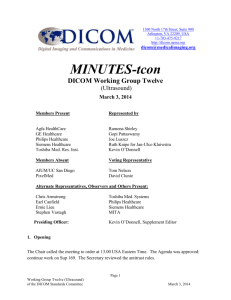
![[#MIRTH-1930] Multiple DICOM messages sent from Mirth (eg 130](http://s3.studylib.net/store/data/007437345_1-6d312f9a12b0aaaddd697de2adda4531-300x300.png)
